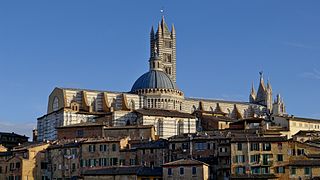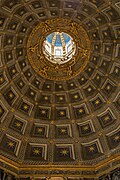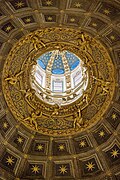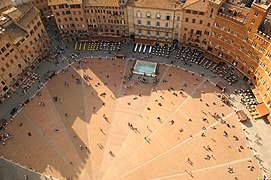Siena
This articleneeds additional citations forverification.(July 2022) |
Siena | |
|---|---|
| Comune di Siena | |
 View of Piazza del Campo (Campo Square), the Mangia Tower (Torre del Mangia) andSanta Maria in Provenzano Church | |
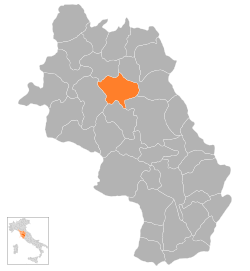 | |
| Coordinates:(53893)43°19′07″N11°19′50″E/ 43.31861°N 11.33056°E | |
| Country | Italy |
| Region | Tuscany |
| Province | Siena(SI) |
| Frazioni | Abbadia,Agostoli,Bolgione,Colle Malamerenda,Costafabbri,Costalpino,Fogliano,Ginestreto,Isola d'Arbia,Le Tolfe,Monteliscai,Pieve a Bozzone,Presciano,Sant'Andrea a Montecchio,Santa Regina,Taverne d'Arbia,Val di Pugna,Vico d'Arbia,Vignano,Volte Alte |
| Government | |
| • Mayor | Nicoletta Fabio(centre-right) |
| Area | |
| • Total | 118 km2(46 sq mi) |
| Elevation | 322 m (1,056 ft) |
| Population | |
| • Total | 53,901 |
| • Density | 460/km2(1,200/sq mi) |
| Demonym | Senese |
| Time zone | UTC+1(CET) |
| • Summer (DST) | UTC+2(CEST) |
| Postal code | 53100, 53010 |
| Dialing code | 0577 |
| Patron saint | |
| Saint day | 1 December 8 October |
| Website | comune.siena.it |
| Criteria | Cultural: (i)(ii)(iv) |
| Reference | 717 |
| Inscription | 1995 (19thSession) |
| Area | 170 ha (420 acres) |
| Buffer zone | 9,907 ha (24,480 acres) |
Siena(/siˈɛnə/see-EN-ə,Italian:[ˈsjɛːna,ˈsjeːna];[4]Latin:Sena Iulia) is acityinTuscany,Italy. It is the capital of theprovince of Siena.Siena is the 12th largest city in the region by number of inhabitants, with a population of 53,062 as of 2022.[5]
The city is historically linked to commercial and banking activities, having been a major banking center until the 13th and 14th centuries.[6]Siena is also home to theoldest bank in the world,theMonte dei Paschi bank,which has been operating continuously since 1472.[7]Several significantRenaissancepainters were born and worked in Siena, among themDuccio,Ambrogio Lorenzetti,Simone MartiniandSassetta,and influenced the course of Italian and European art.[8][9]TheUniversity of Siena,originally calledStudium Senese,was founded in 1240, making it one of theoldest universities in continuous operationin the world.[10][11]
Siena was one of the most important cities inmedievalEurope, and its historic centre is aUNESCOWorld Heritage Site,which contains several buildings from the 13th and 14th centuries.[9][12]The city is famous for itscuisine,art,museums,medieval cityscape and thePalio,a horse race held twice a year inPiazza del Campo.[13][14]
History[edit]
Antiquity[edit]

Siena, like otherTuscanhill towns, was first settled in the time of theEtruscans(c. 900–400 BC) when it was inhabited by a tribe called the Saina. ARomantown calledSaena Juliawas founded at the site in the time of the EmperorAugustus.[15]
According to local legend, Siena was founded bySenius and Aschius,two sons ofRemusand thus nephews ofRomulus,after whom Rome was named. Supposedly after their father's murder by Romulus, they fled Rome, taking with them the statue of the she-wolf suckling the infants (Capitoline Wolf), thus appropriating that symbol for the town.[16]Additionally they rode white and black horses, giving rise to theBalzana,or coat of arms of Siena with a white band atop a dark band. Some claim the name Siena derives from Senius. Other etymologies derive the name from the Etruscan family nameSaina,the Roman family nameSaenii,or theLatinwordsenex"old" or its derived formseneo"to be old".[17]
The first known document of the Sienese community dates back to 70 AD: TheRoman SenatorManlio Patruito reported toRomethat he had been ridiculed with a fake funeral during his official visit to Saena Iulia, a small military colony in Tuscia. The Roman Senate decided to punish the main culprits and to severely call the Sienese to greater respect for Roman authority.[18]
At the end of the third century the city wasChristianizedbySant'Ansano,known as the "Baptizer of the Sienese", who was punished by the Roman authorities governing Siena with the test of fire and boiling oil, imprisonment and finally beheading. During the Middle Ages he was therefore named patron saint of Siena, and the day of his liturgical anniversary came to mark the beginning of the "Contrada Year".[19][20][clarification needed]
Middle Ages[edit]
Feudalpower waned, however, and by the death ofCountess Matildain 1115 the border territory of theMarch of Tuscanywhich had been under the control of her family, the Canossa, broke up into several autonomous regions. This ultimately resulted in the creation of theRepublic of Siena.[15]
The Republic of Siena, established in the 12th century, was a vibrant and influential city-state during the medieval and Renaissance periods. Founded on principles of commerce and governance, Siena quickly became a significant player in the region's political landscape. Siena's economy thrived primarily through its wool industry, which was renowned throughout Europe. The city's strategic location along major trade routes further bolstered its prosperity, allowing Siena to establish trade networks that extended across Europe. This economic success was supported by a well-developed banking system and a strong guild structure that regulated various trades and professions.[21]
Politically, the Republic of Siena was governed by a complex system of councils and magistrates, dominated by powerful noble families who competed for influence and control. The city's political structure evolved over time, with periodic reforms aimed at balancing power and maintaining stability. However, internal rivalries often led to factionalism and occasional civil unrest, one of the main challenges faced by manyItalian city-statesof that period.[21]
Culturally, Siena flourished during thelate Middle AgesandRenaissance,producing notable artists such asDuccio di BuoninsegnaandAmbrogio Lorenzetti.These artists, along with architects and scholars, contributed to the city's rich artistic and intellectual heritage. Siena's distinctive Gothic architecture, exemplified by the iconicDuomo di Sienaand thePalazzo Pubblico,remains a testament to its cultural achievements during this period.[22]During the golden age of Siena before theBlack Deathin 1348, the city was home to 50,000 people.[23]
Despite its cultural and economic prowess, the Republic faced external threats and conflicts, particularly from its rivalFlorence.The rivalry between Siena and Florence intensified throughout the 14th and 15th centuries, culminating in a series of wars known as the Italian Wars. These conflicts ultimately weakened Siena's political and economic position.[6]
From 1547 to 1552, the Spanish-installed governor of Siena wasDiego Hurtado de Mendoza,until he was ousted by a Sienese revolt, which reestablished the Sienese Republic. In theItalian War of 1551–59,the republic was defeated by the rivalFlorencein alliance with the Spanish crown. After 18 months of resistance, Siena surrendered to Spain on 17 April 1555, marking the end of the republic.[24]
Medicean period[edit]
After the fall of the Republic, a few Sienese led by the Florentine exilePiero Strozzi,not wanting to accept the fall of the Republic, took refuge inMontalcino,creating the Republic of Siena sheltered in Montalcino. It lived until 31 May 1559 when it was betrayed by the French allies, whom Siena had always supported, concluding with thePeace of Cateau CambrésiswithCharles V,which effectively ceded the Republic to the Medici.[25]
TheHouse of Medici,apart from the brief parenthesis ofFerdinando I,who tried to create an organized state, were not able to give a stable structure to theGrand Duchy of Tuscany,keeping almost unchanged the division between the so-called Old State, i.e. Florence, and the New State, i.e. Siena and the southern part up toPitigliano,with different laws and taxes. With the death ofGian Gastone de' Medici,(1737), who had no children, the Medici dynasty ended and the Grand Duchy passed into the hands of theHabsburg-Lorraine dynastywho kept it until 1799.[25]
Late modern period[edit]
After theNapoleonic periodand theRisorgimentouprisings, Siena was the first city in Tuscany, in 1859, to vote in favour of annexation to theKingdom of Italy.[26]
Geography[edit]


Siena is located in the central part ofTuscany,in the middle of a vast hilly landscape between theArbiariver valley (south), theMersevalley (south-west), the Elsa valley (north), theChiantihills (north-east), the Montagnola Senese (west) and theCrete Senesi(south-east). The city lies at 322 m (1,056 ft) above sea level.
Climate[edit]
Siena has a typical inland Mediterranean climate. Average rainfall is 750 mm (29.5 in), with the maximum in November and the minimum in July. July is the hottest month, with an average temperature of 22.2 °C (72.0 °F), and January the coldest.[27]
Economy[edit]
The main activities are tourism, services, agriculture, handicrafts and light industry.
In 2009 agricultural activity comprised 919 companies with a total area of 10.755 square kilometres (4.153 sq mi) for ausable agricultural areaof 6.954 square kilometres (2.685 sq mi) or about1⁄30of the total municipal area (dataISTATfor the 2000 Agriculture CensusV).
There is little manufacturing in the city. One exception is the seasonalconfectioneryindustry, which produces local specialities includingpanforte,ricciarelliandcavallucciat Christmas, andpane co' santiforI Santion 1 November andI Mortion the following day.[citation needed]
The area has also seen a growth inbiotechnology.The Centenary Institute Sieroterapico Achille Sclavo used to be Swiss-owned, operating under the company name,NovartisVaccines. Novartis developed and produced vaccines and employed about a thousand people. In 2015, the research plant in Siena became part ofGlaxo Smith Kline,as part of a deal betweenNovartisand this firm.[28]
Government[edit]
Culture[edit]
Contrade[edit]
Siena retains a ward-centric culture from medieval times. Each ward (contrada) is represented by an animal or mascot and has its own boundary and distinct identity. Ward rivalries are most rampant during the annualhorse race(Palio) in the Piazza del Campo.[29]There are 17 wards (contrada): Aquila, Bruco, Chiocciola, Civetta, Drago, Giraffa, Istrice, Leocorno, Lupa, Nicchio, Oca, Onda, Pantera, Selva, Tartuca, Torre, Valdimontone.
The Palio[edit]
ThePalio di Sienais a traditional medievalhorse racerun around the Piazza del Campo twice each year, on 2 July and 16 August. The event is attended by large crowds, and is widely televised. Ten randomly selected from 17Contrade(which are city neighbourhoods originally formed asbattalionsfor the city's defence) vie for the trophy: a painted banner, orPaliobearing an image of theBlessed Virgin Mary.
Art[edit]


Over the centuries, Siena has had a rich tradition of arts and artists. The list of artists from theSienese SchoolincludeDuccioand his studentSimone Martini,Pietro LorenzettiandMartino di Bartolomeo.A number of well-known works ofRenaissanceandHigh Renaissanceart still remain in galleries or churches in Siena.
The Church ofSan Domenicocontains art byGuido da Siena,dating to the mid-13th century. Duccio'sMaestà,which was commissioned by the City of Siena in 1308, was instrumental in leading Italian painting away from the hieratic representations ofByzantine artand directing it towards more direct presentations of reality. And hisMadonna and Child with Saintspolyptych,painted between 1311 and 1318, remains at the city'sPinacoteca Nazionale.
The Pinacoteca also includes several works byDomenico Beccafumi,as well as art byLorenzo Lotto,Domenico di BartoloandFra Bartolomeo.
Main sights[edit]



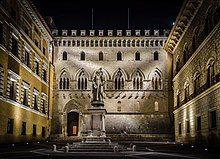

TheSiena Cathedral(Duomo), begun in the 12th century, is a masterpiece of ItalianRomanesque–Gothic architecture.Its main façade was completed in 1380 with a nave oriented northeast–southwest. A proposed expansion of the eastern transept would have transformed the church into an ambitiously massive basilica, the largest then in the world, with an east–west nave. However, the scarcity of funds, in part due to war and the Black Death, truncated the project. Two walls of this expanded eastern transept remain; through an internal staircase, visitors can climb for a grand view of the city.
TheSiena Cathedral Pulpitis an octagonal 13th-century masterpiece sculpted byNicola Pisanowith lion pedestals and biblical bas-relief panels. The inlaid marble mosaic floor of the cathedral, designed and laboured on by many artists, is among the most elaborate in Italy. The Sacristy and Piccolomini library have well-preservedRenaissancefrescos byGhirlandaioandPinturicchiorespectively. Other sculptors active in the church and in the subterraneanbaptistryareDonatello,Lorenzo Ghiberti,Jacopo della Querciaand others. The Museo dell'Opera del Duomo contains Duccio's famousMaestà(1308–11) and various other works by Sienese masters. More Sienese paintings are to be found in the Pinacoteca, e.g. 13th-century works byDietisalvi di Speme.
ThePiazza del Campo,the shell-shaped town square, unfurls before thePalazzo Pubblicowith its tallTorre del Mangia.This is part of the site for thePaliohorse race. The Palazzo Pubblico, itself a great work of architecture, houses yet another important art museum. Included within the museum isAmbrogio Lorenzetti's frescoes depicting theAllegory and Effects of Good and Bad Governmentand also some of the finest frescoes ofSimone MartiniandPietro Lorenzetti.
ThePalazzo Salimbeni,located in a piazza of the same name, was the original headquarters and remains in possession of theMonte dei Paschi di Siena,one of the oldest banks in continuous existence in Europe.
Housed in the notableGothicPalazzo Chigi-Saracinion Via di Città is theAccademia Musicale Chigiana,Siena'sconservatory of music.
Other churches in the city include:
- Basilica dell'Osservanza
- San Domenico
- San Francesco
- San Martino
- Santa Maria dei Servi
- Santa Petronilla
- Santi Niccolo e Lucia
- Santo Spirito
- Sant'Andrea Apostolo
- Sanctuary ofSanta Caterina,incorporating the old house ofSt. Catherine of Siena.It houses the miraculousCrucifix(late 12th century) from which the saint received herstigmata,and a 15th-century statue of St. Catherine.
The historicSiena synagogueis also preserved and open to visitors.
The city's gardens include theOrto Botanico dell'Università di Siena,abotanical gardenmaintained by theUniversity of Siena.
TheMedicean Fortresshouses the Siena Jazz School, with courses and concerts throughout the year, and a festival during the International Siena Jazz Masterclasses.
In the neighbourhood are numerous patrician villas, some of which are attributed toBaldassarre Peruzzi:
Sports[edit]

Cycling[edit]

Siena hosts the start and finish of theStrade Bianche,a professionalcycling racefamous for its historic white gravel roads, calledstrade biancheorsterratiin Italian.[30]More than 50 kilometres (31 miles) of the race is run over dirt roads, usually country lanes and farm tracks twisting through the hills and vineyards of the Chianti region. The finish is on thePiazza del Campo,after a steep and narrow climb on the roughly paved Via Santa Caterina leading into the center of the medieval city.[31]
Transport[edit]
- Buses
Siena Mobilitàwas a consortium established in 2005, formed byTiemme Toscana Mobilità,Busitalia Sita NordeByBus,to manage the local public transport in Siena, in its province and regional service toFlorenceandArezzo.From 1 January 2018 Siena Mobilità operated by virtue of the bridge contract between theRegione Toscanaand the companyONE Scarl.[32]
Since 1 November 2021 the public local transport is operated byAutolinee Toscane.[33]
Twin towns[edit]
Siena istwinnedwith:
- Avignon,France[34][35]
- Concord, North Carolina,US, since 2016
- Weimar,Germany, since 1994
- Wetzlar,Germany, since 1987
Gallery[edit]
-
Siena, Campanile Palazzo Pubblico & Duomo
-
Siena, Campanile, Torre del Mangia (Palazzo Pubblico)
-
Siena, Duomo
-
The interior of the dome in the Siena cathedral
-
Interior of the dome at the duomo, Siena
-
Panorama of Siena
-
Piazza del Campo
-
View from the Campanile del Mangia
References[edit]
- ^"Superficie di Comuni Province e Regioni italiane al 9 ottobre 2011".Italian National Institute of Statistics.Retrieved16 March2019.
- ^Data fromIstat
- ^"Popolazione Residente al 1° Gennaio 2018".Italian National Institute of Statistics.Retrieved16 March2019.
- ^Luciano Canepari."Siena".DiPI Online(in Italian).Retrieved28 October2018.
- ^"Indici demografici e Struttura popolazione Siena".Tuttitalia.it(in Italian).Retrieved23 March2023.
- ^ab"Siena | Italy".Encyclopedia Britannica.Retrieved4 June2021.
- ^"Monte dei Paschi di Siena: a brief guide to the world's oldest bank".the Guardian.22 December 2016.Retrieved4 June2021.
- ^"Pinacoteca Nazionale in Siena – Terre di Siena".20 January 2020.Retrieved4 June2021.
- ^ab"Historic Centre of Siena".UNESCO World Heritage Centre. 3 December 2009.Retrieved19 June2012.
- ^"Storia dell'Ateneo | Università degli Studi di Siena".unisi.it.Retrieved4 June2021.
- ^"10 of the Oldest Universities in the World".Top Universities.Retrieved6 November2021.
- ^"Siena in the Middle Ages | by Siena OnLine".sienaonline.Retrieved6 November2021.
- ^"Il Palio di Siena Tutto quello che c'è da sapere Villa Il Patriarca".ilpatriarca.it(in Italian).Retrieved23 March2023.
- ^"Siena: cosa fare, cosa vedere e dove dormire - Toscana.info".Toscana(in Italian).Retrieved23 March2023.
- ^ab"Siena nell'Enciclopedia Treccani".treccani.it(in Italian).Retrieved6 November2021.
- ^TuscanyPeople, Redazione (26 February 2018)."Perché Siena ha la lupa come simbolo della città?".TuscanyPeople(in Italian).Retrieved23 March2023.
- ^"Storia e Origine della città di Siena | Capodannosiena.net".capodannosiena.net.Retrieved23 March2023.
- ^Ferraiuolo, Antonio (5 September 2021).Breve storia di Siena(in Italian). Passerino. pp. 3–4.ISBN9791220842587.
- ^"La Storia di Sant'Ansano".lavocedelpalio.it(in Italian).Retrieved8 July2023.
- ^Giulia."Ansano, storia di un Santo".Fondazione Musei Senesi(in Italian).Retrieved8 July2023.
- ^ab"Siena - Enciclopedia".Treccani(in Italian).Retrieved8 July2024.
- ^"Art and Architecture in Medieval Siena: Reverence and Rivalry in the City of the Virgin".
- ^Smith, T.B.; Steinhoff, J.B. (2012).Art as Politics in Late Medieval and Renaissance Siena.Ashgate Publishing Company. p. 77.ISBN9781409400660.Retrieved14 September2015.
- ^Caravale, Giorgio, autor. (2016).Preaching and inquisition in Renaissance Italy: words on trial.Brill.ISBN978-90-04-32545-6.OCLC1030563659.
{{cite book}}:CS1 maint: multiple names: authors list (link) - ^ab"Siena medicea".movio.beniculturali.it.Retrieved6 November2021.
- ^"Breve storia di Siena Dagli etruschi ai giorni nostri Il Cavalleggero".ilcavalleggero.it(in Italian).Retrieved6 November2021.
- ^"Climate Data from the University of Siena's Meteorological Station (1961–1990) – Achivio Climatico ENEA".Archived fromthe originalon 5 March 2016.Retrieved15 September2015.
- ^"Novartis, gli stabilimenti di Siena passano a Glaxo entro marzo. E attacca il governo sulla maxi-multa".Corriere. 28 January 2015.
- ^Huppert, George (1998).After the Black Death: A Social History of Early Modern Europe(Second ed.).Indiana University Press.p. 36.
- ^"Siena start for Strade Bianche in 2016".Cycling News.11 November 2015.Retrieved6 February2016.
- ^Brown, Gregor (6 March 2015)."Preview: Strade Bianche promises to be a strongman's race".Velo News.Retrieved29 November2015.
- ^"Chi siamo".Siena Mobilità.Retrieved10 June2022.
- ^"Guida al primo giorno di servizio".Autolinee Toscane.Retrieved10 June2022.
- ^"Jumelages et Relations Internationales – Avignon".Avignon.fr(in French). Archived fromthe originalon 16 July 2013.Retrieved13 July2013.
- ^"Atlas français de la coopération décentralisée et des autres actions extérieures".Ministère des affaires étrangères(in French). Archived fromthe originalon 26 February 2013.Retrieved13 July2013.
Sources[edit]
- A Medieval Italian Commune: Siena under the Nine, 1287–1355by Professor William M. Bowsky (1982)
- McIntyre, Anthony Osler.Medieval Tuscany and Umbria(1992)ISBN0-670-83525-0
- Nevola, Fabrizio (2007).Siena: Constructing the Renaissance city(second ed.).Yale University Press.ISBN978-0-300-12678-5.Retrieved1 March2010.
External links[edit]
 Sienatravel guide from Wikivoyage
Sienatravel guide from Wikivoyage








